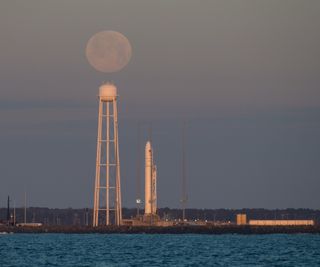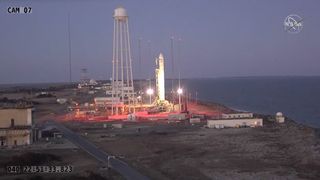Northrop Grumman aborts Cygnus cargo launch to space station
This story was updated 8:42 p.m. EST
WALLOPS ISLAND, Va. — Northrop Grumman aborted the launch of a commercial Cygnus cargo ship to the International Space Station Sunday (Feb. 9) due to a sensor issue at the mission's Virginia launchpad.
The Cygnus spacecraft, filled with NASA supplies, was set to launch atop an Antares rocket — also built by Northrop Grumman — at 5:44 p.m. EST (2244 GMT) from Pad-0A of the Mid-Atlantic Regional Spaceport here at NASA's Wallops Flight Facility. But minutes before that liftoff, Northrop Grumman called off the launch try due to "off-nominal readings from a ground support sensor," the company said in a statement.
NASA and Northrop Grumman are now targeting the launch for no earlier than Thursday, Feb. 13, at 4:05 p.m. EST (2105 GMT), weather permitting. There were launch opportunities on Monday, Tuesday and Wednesday, but Northrop Grumman opted to skip them "due to an unfavorable weather forecast over the next two days, and time required to address the ground support issue," the company said.
The Cygnus spacecraft is packed with 7,600 lbs. (3,400 kilograms) of supplies for the three-person Expedition 62 crew living and working on the space station. The launch had a five-minute window and was aborted more than two minutes into that allotment. Northrop Grumman is still evaluating when to try again.
Related: Bacteria & bone: Here's the science launching on Cygnus NG-13
More: How Northrop Grumman's Antares rockets & Cygnus ships work

During the lead-up to launch, flight controllers paused the countdown at the T-5 minute mark for reasons that were not announced. The Northrop Grumman team then resumed the countdown, then pushed launch from an initial 5:39 p.m. EST target to its final 5:44 p.m. EST time — the end of the window — before scrubbing the launch try altogether. During live audio launch commentary, a mission team member referred to a regulator while discussing the abort, but more details were not yet available.
Get the Space.com Newsletter
Breaking space news, the latest updates on rocket launches, skywatching events and more!
The technical glitch marred an otherwise flawless countdown for Northrop Grumman's Antares and Cygnus vehicles. The launch had a 95% chance of good weather and that forecast appeared to be spot on.
Aside from a light breeze, the sky was a dusky blue, with wisps of clouds and flocks of geese decorating the sky from time to time.

NASA flight controllers at the agency's Mission Control Center have alerted the station's current Expedition 62 crew, which includes American astronauts Jessica Meir, Andrew Morgan and Russian cosmonaut Oleg Scripochka.
As Northrop Grumman reviews Sunday's Antares launch glitch, NASA and the European Space Agency are counting down to a different launch from Cape Canaveral Air Force Station in Florida.
A United Launch Alliance Atlas V rocket is set to launch the joint ESA-NASA Solar Orbiter mission from Cape Canaveral at 11:03 p.m. EST (0403 GMT Feb. 10) to begin an ambitious mission to the sun. The powerful Solar Orbiter is designed to study the sun's polar regions from orbit to better understand the origins of solar weather and the sun's magnetic field.
You can watch the Solar Orbiter launch live on Space.com, courtesy of NASA TV, beginning at 10:30 p.m. EST (0330 GMT Feb. 10).
Editor's note: Space.com senior writer Meghan Bartels contributed to this report from New York City. Editor-in-chief Tariq Malik contributed to this report from NASA's Wallops Flight Facility on Wallops Island, Virginia. This story was updated to include a new launch date for the Cygnus NG-13 mission.
- Cygnus cargo ship leaves International Space Station, begins new mission in orbit
- Antares rocket launches Cygnus cargo ship on marathon mission for NASA
- This NASA experiment shows promise for farm-fresh foods in space
Email Meghan Bartels at mbartels@space.com or follow her @meghanbartels. Follow us on Twitter @Spacedotcom and on Facebook.

Join our Space Forums to keep talking space on the latest missions, night sky and more! And if you have a news tip, correction or comment, let us know at: community@space.com.

Tariq is the Editor-in-Chief of Space.com and joined the team in 2001, first as an intern and staff writer, and later as an editor. He covers human spaceflight, exploration and space science, as well as skywatching and entertainment. He became Space.com's Managing Editor in 2009 and Editor-in-Chief in 2019. Before joining Space.com, Tariq was a staff reporter for The Los Angeles Times covering education and city beats in La Habra, Fullerton and Huntington Beach. In October 2022, Tariq received the Harry Kolcum Award for excellence in space reporting from the National Space Club Florida Committee. He is also an Eagle Scout (yes, he has the Space Exploration merit badge) and went to Space Camp four times as a kid and a fifth time as an adult. He has journalism degrees from the University of Southern California and New York University. You can find Tariq at Space.com and as the co-host to the This Week In Space podcast with space historian Rod Pyle on the TWiT network. To see his latest project, you can follow Tariq on Twitter @tariqjmalik.
